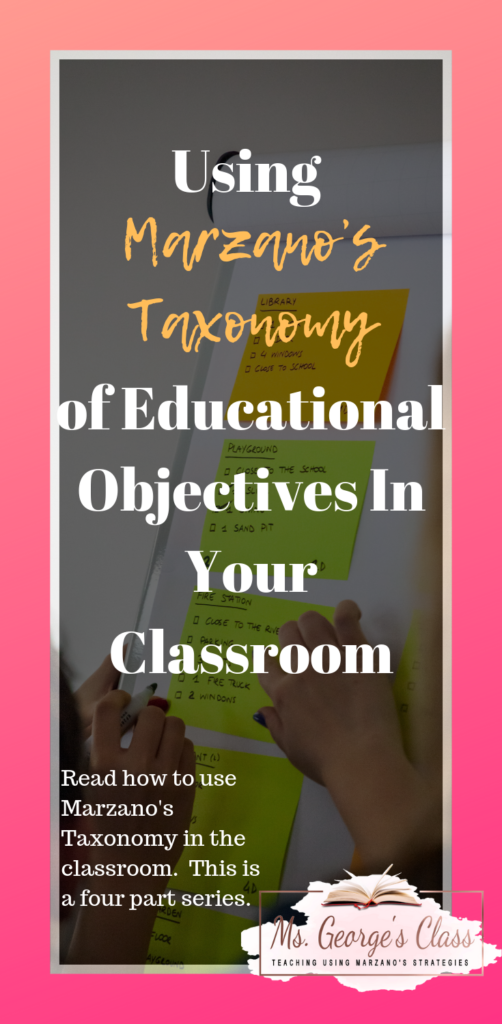A Series 1 of 4

Are you ready to increase student learning by moving students up Marzano’s Taxonomy? Robert Marzano is a leader in the education field, and he has created an updated version of Bloom’s Taxonomy. Marzano’s Taxonomy is based on decades of research and testing. The rigor is more challenging than Bloom’s, and it includes topics such as problem-solving and investigating.
Marzano’s Taxonomy is composed of three main systems and one domain. The three systems are self-system, the metacognitive system, and the cognitive system. Self-system contains emotional issues connected with learning. Metacognitive is how goals are set and monitored, and cognitive is the processing of information. The one domain is the Knowledge Domain, and it relates to content and how it presented. It is gathered through information, mental procedures, or physical procedures.
There are four topics in Marzano’s Taxonomy, compared to Bloom’s. They are
1. Retrieval
2. Comprehension
3. Analysis
4. knowledge utilization.
The basic level is retrieval, and it builds up to knowledge utilization. As a teacher, you want to aim for student growth to reach knowledge utilization.
According to the Marzano’s Taxonomy of Educational Objectives, retrieval is the “activation and transfer of knowledge from permanent memory to working memory.” The first stage of retrieval is recognizing items. This would include true/false statements, matching, or recognizing an accurate statement. Having students select an item from a list would be considered recognizing. Recognizing skills can assist with higher-level assignments, such as writing essays. Students will have to recognize what is being asked to write and what are the expectations of the assignment. When students determine what is being asked, they can produce a piece of writing with accuracy.
Recalling involves “producing accurate information.” These questions are asking students to define, describe, answer the four w (who, what, when, where) questions, label, provide examples of, or retell. The questions may not be challenging, especially if a student reads the text. Recalling questions are often used as guided practice and allow students to recall details about a text.

The last mental process within the retrieval level is executing. This is when a task is carried out. You may have students apply, conduct, demonstrate, perform, read, write, calculate, or complete a task. Teachers may ask questions such as “demonstrate each step, execute the procedure, what is the next step…” The products of these are questions are fill-in-the-blank, label, matching, multiple-choice, and definition.
How You Can Use it in Your Class?
A primary class would use this level of questioning during guided instruction and quick assessment. In upper elementary to high school classes, retrieval questions could be used as a quick review or quick formative assessment. When opening a lesson, use a retrieval question to engage the class. For example, a teacher may state, “Yesterday, we identified two themes from the short story we read. Can you state the two themes?” For a quick assessment, you can have students complete an exit slip. Before exiting the room, have students define the words you discussed during the lesson. If students get all the questions correct, you can move with the lesson. If they struggle with the questions, you should review the lesson. After students achieve success with retrieval questions, teachers need to increase the rigor and move to the next level, which is comprehension. With Marzano’s Taxonomy you can increase student growth by applying rigor to your lessons.

Have you ever used retrieval questioning in your classes and what did you like about it? Leave a message below.
Work Cited
LearningSciencesInternational. Marzano’s Taxonomy of Educational Objectives. Florida. nd. print.




Leave a Reply